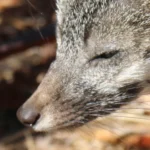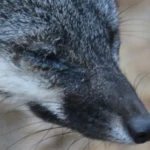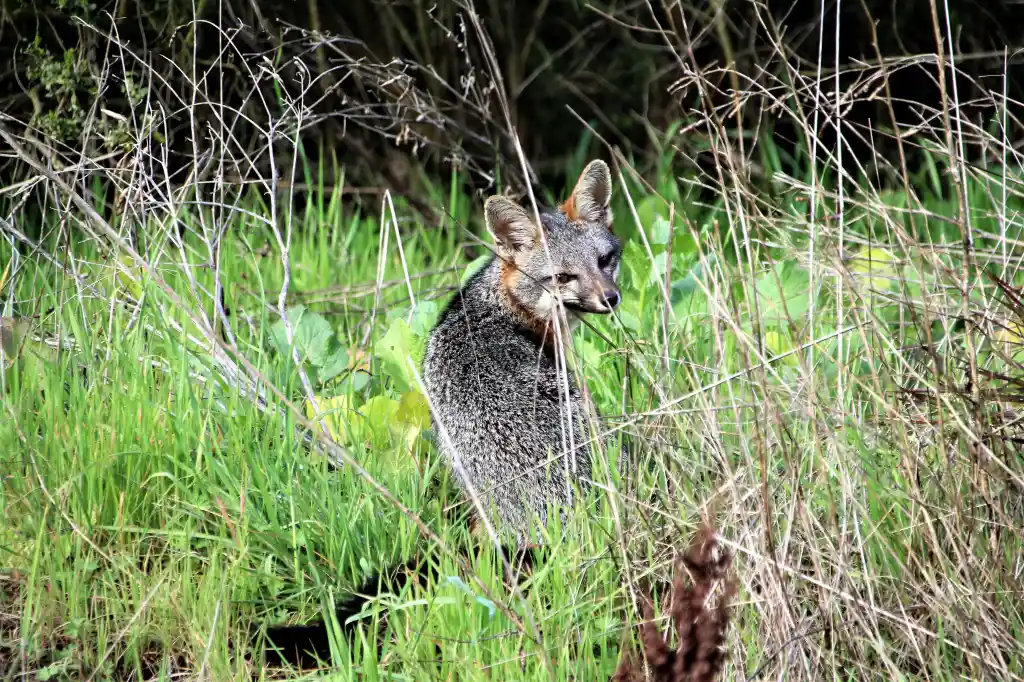Gray Fox Report for September 2016
by William C. Leikam
President, CEO & Co-founder, Urban Wildlife Research Project
One Eye the Pup at the Overflow Channel
 Thursday, September 1, I noticed that one of the gray fox pups that I have come to call One Eye, over on the creek had a swollen left eye. Upon close examination, it looked infected as a dark drainage oozed from the corner of its eye. Over the month, I have watched it develop: The swelling increased and on the upper part of the eyebrow, there appeared to be a small cut as if it had been raked by a claw or something sharp, possibly a dry blackberry thorn, or a jagged, broken branch. The ooze decreased then returned. This cycle has occurred upward of four times over the course of the month.
Thursday, September 1, I noticed that one of the gray fox pups that I have come to call One Eye, over on the creek had a swollen left eye. Upon close examination, it looked infected as a dark drainage oozed from the corner of its eye. Over the month, I have watched it develop: The swelling increased and on the upper part of the eyebrow, there appeared to be a small cut as if it had been raked by a claw or something sharp, possibly a dry blackberry thorn, or a jagged, broken branch. The ooze decreased then returned. This cycle has occurred upward of four times over the course of the month.
Gray the Alpha Male at the Embarcadero

Once again, almost non-stop from more than a year ago, Gray has a new infection that bothers him so much that he frequently wipes his eye with his dew claw. Early in the month, he had that ugly puss-like drainage at the corners of both eyes, but as time passed the right eye cleared up, leaving only his left eye infected. From my log of September 17, 2016, “Gray’s left eye is infected. It’s running and nearly closed.” His eye got worse and several days later Gray was essentially blind. By the end of the month, on September 28, 2016 Gray’s eye seems to be almost clear of any drainage, but given past performance it’s apt to come again. I am beginning to suspect that at least with Gray that this infectious bacterium is systemic; it lives within his system.
One of Gray’s pups also has such drainage in its left eye.
Dark the Alpha Male at the Overflow Channel
Alpha male Dark is almost a repeat of Gray’s condition. The only exception is that Gray has had these eye infections far longer than Dark. I wondered why it was that these foxes tend toward getting these infections. Is it something in the environment? Did the infected foxes get into a fight? Did each one collide with something and then become infected?
As a conclusion, I need to point out that not all of the foxes that I monitor are so infected. Most of them have clear eyes. Some of the others have other problems as I have reported in the past such as at certain times of the year being infested with vermin of at least five kinds, and/or leg and ear injuries due to fights generally occurring over food.
General Health of the Gray Foxes
Gray fox scat is the most direct way to tell how healthy the population is or how compromised it may be. Other than my previous report of the two pups in the August Gray Fox Report, the scat appears to reflect a relatively healthy gray fox population at the baylands. Endemic to these mammals are worms in their digestive tracts. Both Dark Eyes and Cute show the presence of worms in their scat.
Total Numbers Of Gray Foxes in the Palo Alto Baylands Preserve
This month I need to modify the number of gray foxes in the area. The foxes that once lived at the golf course have moved. According to one of the workers reshaping the area, they have retreated on over across San Francisquito Creek near the Friendship Bridge. That means that five foxes are no longer being tracked leaving a total of 17 foxes living between Embarcadero Road and Adobe Creek. I might add here that there are gray foxes living in the thickets along the overflow channel that are wild and do not show themselves.
Update for the Urban Wildlife Research Project – Greg Kerekes & Bill Leikam
As an update on events occurring with the Urban Wildlife Research Project:
As of last Friday, September 30, 2016, a new video about the fox work at the baylands was produced and posted online by the Peninsula Open Spaces Trust (POST). http://archives.sfweekly.com/sanfrancisco/fox-news-wildlife-corridor-bill-leikam-gray-fox-lord-of-the-rings-menlo-park-south-bay-facebook-moffett-field-wetlands-preservation-m/Content?oid=4842684&showFullText=true
If you haven’t had a chance to read at least some of the articles that have been written about our study of gray fox behavior and our corridor work, click on these links as they will take you to the source: Bill Leikam – The Fox Guy and Greg Kerekes and UWRP.
Beth Pratt-Bergstrom’s new wildlife book When Mountain Lions Are Neighbors covering not only Mt. Lions but as well other wildlife, has been officially released on the book shelves as of August 1, 2016. Within, the book there is a chapter that covers the Urban Wildlife Research Project’s documentation of the gray fox. Please purchase a copy of this valuable book. All proceeds will be used to fund these important wildlife projects in California. To purchase through Amazon.
To find out more about us, search Greg Kerekes, Bill Leikam – The Fox Guy, Urban Wildlife Research Project, UWRP, gray foxes, corridors, and more.
We changed the URL for our website to UrbanWildlifeResearchProject.com.
Check out our UWRP Facebook Page.
Within the permit that allows the Urban Wildlife Research Project to conduct its study of the behavior of the gray fox, the objectives covered are:
Monitoring of urban gray fox denning sites in Palo Alto Baylands.
This is being accomplished during the period when the gray foxes use a den site. It is one of the prime locations for gathering most of the behavioral data on the litter and on adults alike.
Assessment of status and population trends of Bayland’s urban gray foxes.
See above – As of June 2015, it appears as though the number of gray foxes at the baylands has declined considerably. This brings up the question: As with coyotes that can regulate the number of pups born in a region, might also gray foxes do the same?
Identification of habitat features that promote the presence of urban gray foxes.
As stated in a previous gray fox report, there is a need to undertake some work to increase the habitat features required by the gray foxes and other wildlife in an area where a road was built that borders the saltwater channel. I asked construction supervisor Frank Muzzi about this and he felt that the old growth Coyote Bush would grow back within the coming year and therefore accomplish the same goal. After considering this and talking with people who know how to restore habitats, we need to assess what kinds of plants would grow best along the edge of the saltwater channel and alongside the marsh. The Alkaline Saltbush is one but there are probably others as well. We need to grow a permanent habitat that contains the corridors and plant it as soon as possible. We’ll keep an eye on this as this is a critical link between the southern region of the baylands and the northern region.
Assessment of reproductive success and identification of factors that promote successful reproduction.
Last month I wrote that gray fox reproduction at the baylands appears to be holding steady with an average of 3.3 pups developing to maturity during the 2013 and 2014 seasons. As noted above, the 2015 season has fewer pups than in years past.
Solution? Open up the pinch-point along Matadero Creek by developing thickets that link one area to another.
Identification and assessment of possible dispersal travel routes.
Presently there can only be guesses as to dispersal travel routes. We intend to make this important question much more concrete when we attain our collaring/take/capture permit from the Department of Fish & Wildlife.
Until next month, I hope that your endeavors are productive and rewarding. Take care.
Bill Leikam – The Fox Guy
Urban Wildlife Research Project
Thank You to Our Partners.




